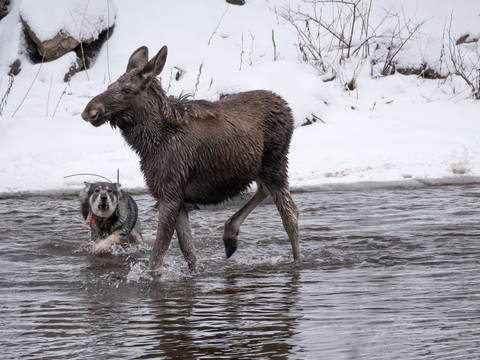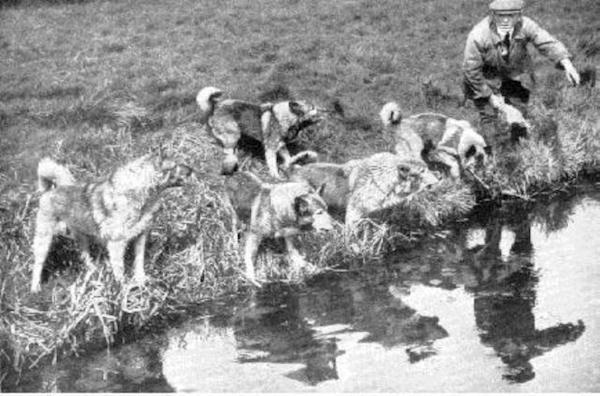
According to the Norwegian Elkhound Association of America’s Illustrated Standard, most hunting trials in Norway give an Elkhound six hours to hunt. The dog is rated in five categories (with 100 as a perfect score), and among the expectations is that the dog initiate a wide search for a moose without losing contact with his handler. “In his confrontation with a moose, the dog should bark to hold the moose and to signal his handler. If the moose begins to move, the dog stops barking and follows silently. When the moose stops, the confrontation begins again.”
The idea is for the Elkhound to hold the game at bay by snapping, growling, barking his loud and powerful bark, and bouncing back and forth toward the moose to draw its attention (and to alert the hunter of their location). His job is to be an annoying, but not lethal threat. He approaches the moose head on, circling and pretending to be a target, but must also be able to jump instantly in any direction using his agility to escape harm’s way.
An Elkhound is expected to be able to hold a moose at bay like this for over an hour. An unsound Elkhound will not survive an irritated moose, nor will a hunter have much use for such a dog that lacks the stamina and agility to hunt day after day on varied terrain in terrain in snow, sleet, cold rain, and/or freezing temperatures.
Every other year, Finland, Sweden and Norway take turns organizing the Nordic Championships in hunting trial for Elkhounds. The trial is organized according to the rules of the country organizing the competition. In addition to the trial’s dog-specific results, there is a competition for team results (you can read the rules here).
The photo below came from Hutchinson’s Dog Encyclopedia, and one can almost hear these Elkhounds are barking, a typical behavior whenever the breed corners prey, and one that entitles the breed to be considered a “bark pointer.”

How important are dogs to a hunter in Norway? For starters, only dogs that qualify in the Norwegian Hunting Trials may be awarded the title of breed champion in Norway.
But when hunting moose, red deer and roe deer, both hunting parties and individuals hunting alone are required to have a trained dog available to locate animals that have been shot, but not found. If such a dog isn’t present while the hunting is in progress, written agreement has to be obtained ensuring the availability of such a dog within a reasonable time after the quarry has fallen. The local authority may require documentation showing compliance with these conditions.
Image: Elkhound with Moose © Terje Groenli/Dreamstime.com
